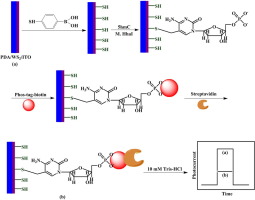Chemical Engineering Journal ( IF 15.1 ) Pub Date : 2018-09-18 , DOI: 10.1016/j.cej.2018.09.138 Yunlei Zhou , Huanshun Yin , Chengji Sui , Yue Wang , Shiyun Ai

|
A simple and selective photoelectrochemical method was reported for 5-hydroxymethylcytosine (5hmC) detection in genomic DNA based on DNA methyltransferase (MTase) catalytic covalent bonding of –CH2OH of 5hmC with thiol compounds, where WS2 nanomaterial was used as a photoactive material, polydopamine (PDA) was employed as a solid-phase electron donor, phos-tag-biotin was used as bridge to link 5hmC and streptavidin. PDA was attached to 4-mercaptophenulboronic acid (MPBA) via the covalent bonding between its vicinal diol and the boracic acid of MPBA. Then, under the catalytic effect of M. HhaI MTase, 5hmC deoxyribonucleotide was captured on electrode surface through the covalent bonding between –CH2OH and –SH. Afterwards, phos-tag-biotin, a kind of specific reagent for phosphate group, was further captured through the specific bonding between the phosphate group of 5hmC deoxyribonucleotide and phos-tag-biotin. Subsequently, based on the “bridge” role of phos-tag-biotin, streptavidin was further modified on electrode surface to further block the transfer of photogenerated-electron to electrode surface. The photocurrent shows linear relationship with the logarithm value of 5hmC concentration in the range from 0.01 to 100 nM, and the detection limit of 4.12 pM (3σ). The developed method presents high detection specificity, which can discriminate 5-methylcytosine and 5hmC. Moreover, the applicability of this photoelectrochemical method was evaluated by detecting 5hmC content change in maize seedlings leaves and chicken embryo fibroblast cell.
中文翻译:

基于M. HhaI甲基转移酶催化共价键的光电化学检测基因组DNA中的5-羟甲基胞嘧啶
据报道,一种简单而选择性的光电化学方法可检测5hmC的–CH 2 OH与硫醇化合物的DNA甲基转移酶(MTase)催化共价键合,从而在基因组DNA中检测5-羟甲基胞嘧啶(5hmC),其中WS 2纳米材料用作光敏材料,使用聚多巴胺(PDA)作为固相电子供体,使用phos-tag-biotin作为连接5hmC和链霉亲和素的桥。PDA通过其邻位二醇和MPBA的硼酸之间的共价键连接到4-巯基苯硼酸(MPBA)。然后,在M. HhaI MTase的催化作用下,通过–CH 2之间的共价键将5hmC脱氧核糖核苷酸捕获在电极表面上。OH和–SH。然后,通过5hmC脱氧核糖核苷酸的磷酸基团与phos-tag-生物素的特异性键合,进一步捕获了磷酸酯-生物素(一种磷酸基团的特异性试剂)。随后,基于磷酸-标签-生物素的“桥”作用,抗生蛋白链菌素在电极表面被进一步修饰,以进一步阻止光生电子向电极表面的转移。光电流与5hmC浓度的对数值在0.01至100nM之间,检测极限为4.12pM(3σ)之间呈线性关系。所开发的方法具有很高的检测特异性,可以区分5-甲基胞嘧啶和5hmC。此外,通过检测玉米幼苗叶片和鸡胚成纤维细胞中5hmC含量的变化,评价了这种光电化学方法的适用性。



























 京公网安备 11010802027423号
京公网安备 11010802027423号